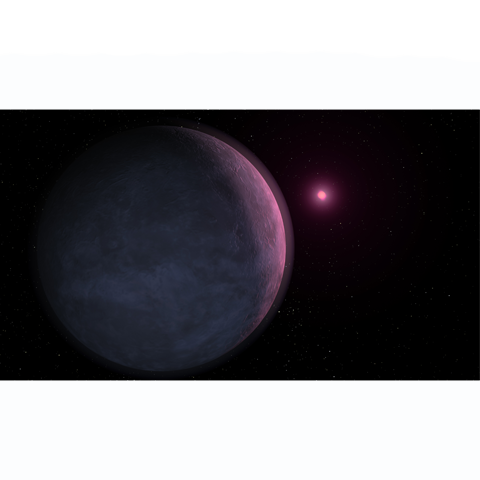Science news
2-Jun-2008 13:00 Eastern US Time
Tiny planet of a tiny star
An international team of astronomers led by David Bennett of the University of Notre Dame has discovered an extrasolar planet of about three times the mass of the Earth. It is in orbit around a star with a mass so low that its core might not be large enough for nuclear reactions. The result was presented today (June 2) at the American Astronomical Society annual meeting in St. Louis.
Astronomers call the planet MOA-2007-BLG-192Lb. It now holds the record for the lowest mass planet in orbit around a reasonably normal star.
Mass matters
The star itself, known as MOA-2007-BLG-192L, is 3,000 light years from Earth and has a mass about 6% of the mass of the sun.
This is slightly below the mass needed to sustain nuclear reactions in the core. So a star like this is called a 'brown dwarf', because it doesn't shine like normal stars. Given the measurement uncertainties though, it is just possible that the star's mass could be as high as 8% of the mass of our sun. This would make MOA-2007-BLG-192L not a brown dwarf but a very low mass, hydrogen-burning star.
The discovery shows that even the lowest mass stars can have planets, says Bennett. "No planets have previously been found to orbit stars whose mass is less than about 20% of that of the sun. But this finding suggests that we should expect very low-mass stars near the sun to have planets with a mass similar to that of Earth."
This is particularly interesting because it means astronomers could use NASA's planned James Webb Space Telescope to search for signs of life on such planets.
Bending light
The discovery of the MOA-2007-BLG-192L star-planet system was made by the Microlensing Observations in Astrophysics (MOA) and the Optical Gravitational Lensing Experiment (OGLE) collaborations. Bennett belongs to MOA.
The scientists used gravitational microlensing to detect the planet. This works because the mass of a star - or any other big lump of matter - warps nearby space. This means that light rays from another star farther away are bent as they pass close to the star - just as light rays are when they pass through a lens. Hence the name.
If the two stars are directly in line as seen from Earth, this lensing makes the farther star appear much brighter. Now if the nearer star has a planet in the right position this planet can also bend the light. That causes another, small increase in brightness. This can last for a few hours or days until the planet moves out of position.
Microlensing methods
For planet hunters, such a temporary increase in brightness is the telltale sign of a planet. What's more, the details of how the brightness rises and then falls again tells scientists a great deal about the planet itself. Its total mass, its orbit and its period can all be worked out very accurately.
These microlensing events are rare and brief. The discovery was made possible by the new MOA-II telescope at New Zealand's Mt. John Observatory, using the MOA-cam3 camera. This can form images of an area of sky 13 times larger than the full moon.
"The new MOA telescope-camera system allows us to monitor virtually all of the known microlensing events for planetary signals," Bennett said. "We would not have made this discovery without it."
New planet stats
The microlensing observations showed that the mass of the host star is about 6% of the mass of the sun. This was confirmed by adaptive optics images using the Very Large Telescope (VLT) at the European Southern Observatory in Chile. These images confirm that the host star is either a brown dwarf or a very low-mass star.
The planet has an orbit similar to that of Venus in our own solar system. But to anyone on the planet its sun would be between 3,000 and 1 million times fainter than our sun seen from Earth. This means that the top of the planet's atmosphere is likely to be colder than Pluto.
But astronomers believe that the planet is likely to have a thick atmosphere. So things could be much warmer down below. It is even possible that heating of the interior of the planet by radioactivity might make the surface as warm as Earth's.
Planet-hunter prediction
This new discovery supports the prediction made by Bennett and Sun Hong Rhie in 1996 that the microlensing method is sensitive enough to detect planets like Earth.
"I'll hazard a prediction that the first extrasolar Earth-mass planet will be found by microlensing," Bennett says.
"But we'll have to be very quick to beat the radial velocity programs and NASA's Kepler mission, which will be launched in early 2009."
A paper describing this result has been accepted for publication in the Astrophysical Journal and is scheduled for publication in the Sept. 1 edition. Bennett's work is funded by the National Science Foundation and the National Aeronautics and Space Administration.
More help with words
| atom | estimated | fission | fusion | gravitation |
| nuclei | nucleus | orbit | planet | proton |
| neutron | solar system |


